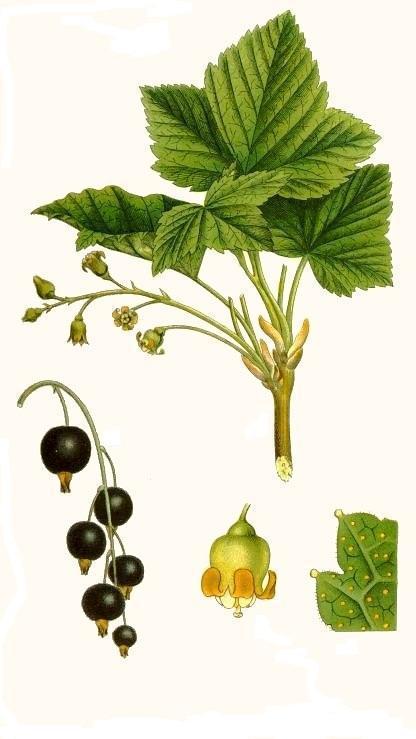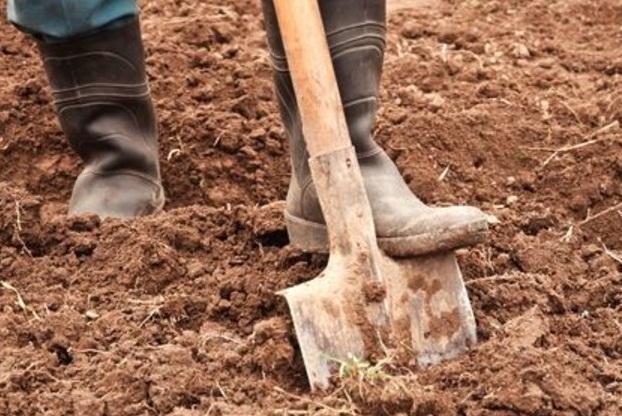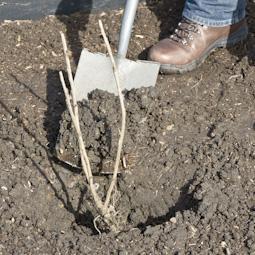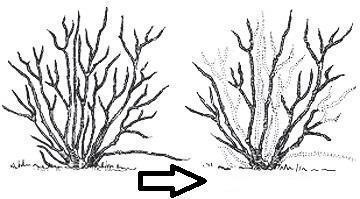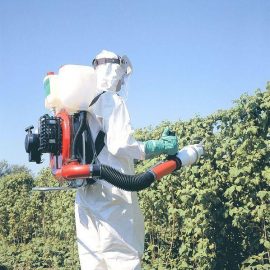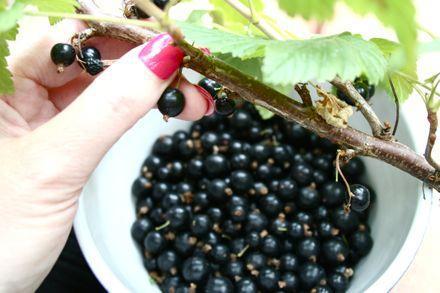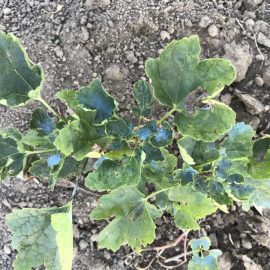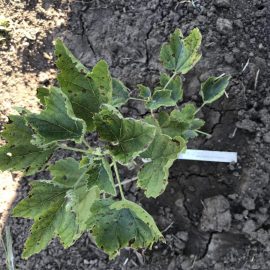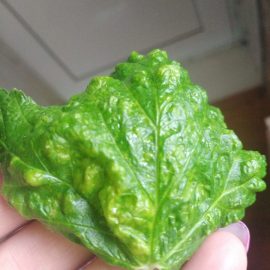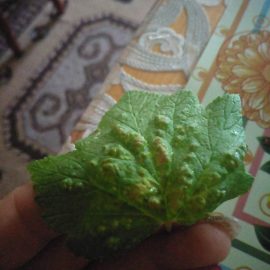Blackcurrant, planting, growing and harvesting
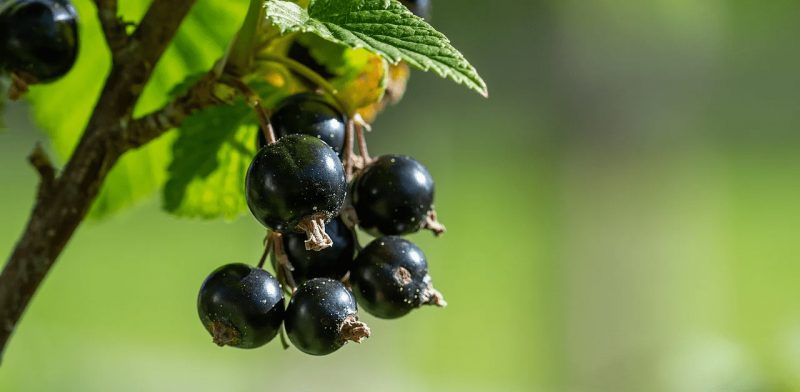
The blackcurrant or European black currant (Ribes nigrum) is a rustic species with high biological potential, capable of yielding 5-8 tons/ha. It grows spontaneously in mountainous areas of Europe (Alps, Carpathians), Asia, and North America. In the first 2-3 years after planting, the currant bush produces a small amount of fruit, but after this period, the bush reaches its biological production potential.
The berries of the blackcurrant bush are an important source of nutrients, with a high content of sugars, organic acids, sodium, potassium, calcium, iron, dietary fiber, and vitamins (A, D, C, B6, B12).
Botanical characteristics
The blackcurrant is a 1-1.5 m high shrub with an erect growth, forming 15-25 stems. In the soil, it develops a strongly ramified root system, at a depth of 15-50 cm. The shallow development of the root system requires careful maintenance to avoid damaging the roots. The stems grow vigorously in the first years, then the growth intensity decreases. Young blackcurrant branches are delicately pubescent, gray-reddish in color, with small glands (which emit an intense, specific smell). The buds are 5-8 mm long, and oval. Blackcurrant leaves are long petiolate, covered with hairs, with serrated edges, and the flowers are clustered in raceme-like inflorescences. The fruit is a round berry, which can reach 20 mm in diameter and it is black. The shrub blooms in April-May, and the fruits ripen in July. Pollination is carried out by insects (entomophilous).
Environmental requirements
The blackcurrant tolerates semi-shade well, but its biological potential is manifested in full-light conditions. The best productions are obtained in areas where the average annual temperature is between 7.5℃ and 8.5℃. During the dormancy period, the shrub withstands temperatures as low as -28℃, but the high temperatures during the summer can be harmful. At 30℃, the shrub may lose its leaves, the fruits ripen prematurely, remaining small and falling off. The shrub requires at least 700 mm of rainfall/year. The soil should be fertile, deep, with a clayey texture, and with good drainage.
Soil preparation
Choose the land according to the pedo-climatic requirements of the shrub. The selected plot should be located at least 500 m away from busy roads and 15-20 km away from industrial pollutants. The land slope should not exceed 10-15%.
The best preceding crops for blackcurrant are annual or perennial legumes (peas, beans, clover, alfalfa), as well as some technical plants (rape, mustard, Tagetes sp.). The soil should be prepared at least 60 days before planting, and if it is heavily infested with weeds, apply a non-selective herbicide.
Recommended products
-
You can find products on a different store
Change Store -
You can find products on a different store
Change Store -
You can find products on a different store
Change Store -
You can find products on a different store
Change Store -
You can find products on a different store
Change Store -
You can find products on a different store
Change Store -
You can find products on a different store
Change Store -
You can find products on a different store
Change Store -
You can find products on a different store
Change Store -
You can find products on a different store
Change Store -
You can find products on a different store
Change Store -
You can find products on a different store
Change Store -
You can find products on a different store
Change Store -
You can find products on a different store
Change Store -
You can find products on a different store
Change Store -
You can find products on a different store
Change Store -
You can find products on a different store
Change Store -
You can find products on a different store
Change Store -
You can find products on a different store
Change Store -
You can find products on a different store
Change Store -
You can find products on a different store
Change Store -
You can find products on a different store
Change Store -
You can find products on a different store
Change Store -
You can find products on a different store
Change Store
Planting
The optimal planting season is between the end of October and the first decade of November. To obtain a precise plantation, the land can be picketed (the place of each shrub is marked in the plot). The recommended planting scheme is 3 m distance between rows and 1 m distance between plants per row. The pits should be made near the pickets on the day of planting or a few days before and should measure 40x40x30 cm. The planting material should be obtained only from authorized nurseries.
A mixture of well-fermented manure and soil (resulting from digging the pit) should be introduced at the base of each pit. Place the planting material in the pit so that 5-6 cm of the stem gets covered with soil. Finally, water the saplings thoroughly. After planting or in spring, shorten the shrubs to 10-12 cm.
Maintenance work
Pruning
It would help if you carried out the crown formation prunings in the first years after planting. The resulting bush should be able to bear fruits from the third year. The largest quantities of fruit are obtained on the 2nd and 3rd year branches. In the second year after planting, choose 4-6 stems, and shorten them to 40 cm, removing the rest from the insertion point. Remove weak growth and branches affected by frost or disease. In the third year, besides the 6 stems, choose 4-6 more shoots, which will be left to grow. The ramifications grown on the first 6 stems should be shortened to 15-20 cm.
In the fourth year, choose 18-20 healthy stems (of various ages) and remove the extra ones from the ground. Remove small, weak vegetative growths by pruning above an outward-facing bud. In this way, the stem that will develop from the bud will replace the removed one. Next year’s pruning should aerate and rejuvenate the bush. Remove diseased or dry branches and those that are 4 years old. Choose 18-20 healthy branches between one and three years old and shorten them by 1/3 of their original length.
Recommended products
-
You can find products on a different store
Change Store -
You can find products on a different store
Change Store -
You can find products on a different store
Change Store -
You can find products on a different store
Change Store -
You can find products on a different store
Change Store -
You can find products on a different store
Change Store -
You can find products on a different store
Change Store -
You can find products on a different store
Change Store -
You can find products on a different store
Change Store -
You can find products on a different store
Change Store -
You can find products on a different store
Change Store -
You can find products on a different store
Change Store -
You can find products on a different store
Change Store -
You can find products on a different store
Change Store -
You can find products on a different store
Change Store -
You can find products on a different store
Change Store -
You can find products on a different store
Change Store -
You can find products on a different store
Change Store -
You can find products on a different store
Change Store -
You can find products on a different store
Change Store -
You can find products on a different store
Change Store -
You can find products on a different store
Change Store -
You can find products on a different store
Change Store -
You can find products on a different store
Change Store
Soil maintenance
After planting, the interval between rows should be kept clean in the first few years by mulching and repeated hoeing. Maintenance work should be carried out carefully so as not to damage the root system. From the third year onwards, you can use approved herbicides. The interval between rows can be cultivated with white clover (Trifolium repens). This species does not compete with the blackcurrant for water and nutrients.
Trellising
To facilitate the maintenance work and the harvesting, trellising of the blackcurrant plantation is recommended. The trellising systems consisting of trellis and wire can be used in commercial blackcurrant plantations. In the case of small areas, plants can be trellised with support stakes.
Irrigation
Irrigation is mandatory in areas where rainfall does not provide the required water, a minimum of 700 mm/year. Normally, 4-5 irrigations with norms of 400-500 cubic meters/ha are sufficient. Irrigation can be applied by sprinkling, furrow, or drip irrigation.
Fertilization
To reach its production potential, the crop needs additional fertilization. The optimum time for fertilizer application is November-February. These fertilizers can be incorporated into the soil with a 10-15 cm deep hoeing.
Also, regular application of water-soluble fertilizers through drip irrigation is an efficient method of fertilization, so that plants can constantly benefit from the necessary elements.
Depending on the phenotype, apply root fertilizers with macro and microelements in the required quantities.
Root fertilization can be supplemented with foliar fertilizers, depending on the plant’s needs and environmental conditions.
Recommended products
-
You can find products on a different store
Change Store -
You can find products on a different store
Change Store -
You can find products on a different store
Change Store -
You can find products on a different store
Change Store -
You can find products on a different store
Change Store -
You can find products on a different store
Change Store -
You can find products on a different store
Change Store -
You can find products on a different store
Change Store -
You can find products on a different store
Change Store -
You can find products on a different store
Change Store -
You can find products on a different store
Change Store -
You can find products on a different store
Change Store -
You can find products on a different store
Change Store -
You can find products on a different store
Change Store -
You can find products on a different store
Change Store -
You can find products on a different store
Change Store -
You can find products on a different store
Change Store -
You can find products on a different store
Change Store -
You can find products on a different store
Change Store -
You can find products on a different store
Change Store -
You can find products on a different store
Change Store -
You can find products on a different store
Change Store -
You can find products on a different store
Change Store -
You can find products on a different store
Change Store
To help plants overcome periods of stress, you can carry out foliar and root fertilization with plant stimulators. Root fertilizers can be applied to improve soil structure and root uptake.
Pest control
The phytosanitary condition is very important, the blackcurrant being affected by a series of diseases and pests. Cultural hygiene is one of the measures to prevent diseases and pests. This consists of pruning, gathering, and burning the stems and shoots that are dry or affected by diseases and pests. Additionally, the leaves should be incorporated into the soil through shallow hoeing. The cultural hygiene works must be carried out in the dormancy period (winter).
Harvesting
The berries must be harvested when the fruit at the top of the clusters is pinkish-green. The fruit ripens in a staggered manner, from the base of the cluster to the top. Harvesting should be done in cool, dry weather and the fruit should be stored immediately in packages. It is recommended to use small packages so that the fruit is not damaged (max 5 kg). The berries can be stored in cool rooms for 10 days when harvested at the optimum time. In controlled-atmosphere storage, the fruit can be stored for 35 days.














































































































































































































































































































































































































































